by Wallace Wyss and David Lawrence Silver –
When word filtered out that a 1957 356A Porsche Speedster had sold for $660,000 at auction, it was assumed by many that, ho hum, that had to be one of the rare 4-cam Carrera Speedsters.
Wrong. The Auctions America sale was not for a four cam Type 547/1 Carrera but for a pushrod car.
Carrera Speedsters have gone for close to a million dollars at auction. Add the luster of documented participation in an original era race of some importance, like LeMans, and you have a car that’s as good as gold.
But this was not a former race car with Le Mans in its logbook, not even Sebring. In fact, no logbook at all because it had never raced.
Can we assume then that the outsize bid was because it was a Speedster, and Speedsters are so rare and so desirable, that’s why it fetched so much? No, because first of all there were over 76,000 Porsche 356 models made so it’s not a rare car like a Ferrari Daytona (under 1,400 made) or DeTomaso Mangusta (402 made). There were thousands of Speedsters made from model year ’55 through ’58, somewhere North of 4,000.
So now we’re back to Ground Zero in trying to divine why it sold for so much.
When all else fails, I say go to the auction description.
First of all, it was an original car, sold on May 31, 1957 to John Casper for $3,502.00.
Second, the car was unsullied by race car use.
Oh, he went to the track but just as a spectator.
And it was only driven in summer, thus avoiding the salt on the road common in the Rust Belt.
It came with beau coup documentation like the original service booklet with only a couple pages removed at the beginning from when it was serviced with a few hundred miles. There are stickers in the door jamb showing services completed when the car had roughly 25,000 miles.
The last year that this Porsche was driven on the roads was 1975. So over a quarter of a century ago the car was put into storage. From 1957 to 1975, the car was driven an average of 1,722 miles per year, a true “time warp” car.
The original convertible top boot and top came with the car. The beige interior had no tears or sign of misuse. The interior also has the original VDO instrumentation, Porsche steering wheel; and cigar lighter.
The Porsche Certificate of Authenticity verified it came with the paint on it at the auction, Aquamarine Blue Metallic (5607) with a Beige Leatherette interior. Optional equipment included USA bumpers, sealed beam headlights and Coupe seats in place of the Speedster seats. It is also fitted with a Raydyot fender-mounted mirror. It has never been resprayed or had body work.
The original owner died around five years ago. After his passing, a lifelong family friend acquired the Porsche from the estate in 2016. When going through the paper work with the family, the original title was found for the Porsche proving beyond all doubt that it had enjoyed single ownership for the last 59 years. The original owner’s manual, spare tire and jack were of course included with the vehicle.
The auction description ended with these words:
As more Porsche Speedsters are found and restored; it is becoming nearly impossible to find such an original car, with a spectacularly documented history and long-term single ownership. It is conveyed that the doors close excellent with a sweet solid sound; and the near perfect fit and finish of all the panels and gaps is rarely going to be found on another original Porsche.
An automobile is only original once.
OK give that auction company copywriter a big fat bonus because his pitch for it being a “time warp” car sold the car. A car unmolested by many owners, unhit and never repaired badly, a car that never suffered the urge of the owner to “update this” and update that. It was a chance to go back in the time machine and buy one, albeit at 100 times the price of just a few years ago.
We bring to this commentary some years of experience, one of us (Wyss) as a sometimes barn finder, and the other (Silver) as a fine art dealer and car collector.
We both were knocked off our chairs by this sales price—which was far above even the auction company’s estimates (and puts the Auction America auction house a few notches up, though they were started as a “sub company” to RM Auctions, a more prestigious auction house.)
When an auction price like this Speedster comes along, it is, in our view, a game changer, signaling a re-think of the entire collector car market is in order.
Here’s our theories:
THE ART MARKET IS ROTTEN, HENCE THE RICH NEED A NEW PLACE TO PARK THEIR MONEY
If you followed the saga of Andy Warhol prints, you find that there are a lot of fake Warhol prints and those who decided which are real and which are fakes have for the most part lost their way so some who paid millions for a print are now suing because they feel the artwork was mis-represented.
When you have a car like this Speedster, whose SN has been documented by the factory, and whose entire history is known, it makes it a more secure investment than art work. Don’t forget, Warhol’s studio wasn’t called “the factory” for nothing, he had dozens of employees making the work for him; who’s to say they didn’t run off a few more they didn’t tell him bout or gear up production after Andy died?
In sum, you could say “Collector cars are the new art.” Good investments and a lot more fun to drive around than a canvas print.
In the annual publication, “Art at Auction, The Year at Sothebys and Parke-Bernet, 1965-66” Michael Sedgewick states, and we quote, “Now Veteran and Vintage Cars are almost objects d’art.”
He goes onto state about valuations in 1965, “All the same, prices have increased. In 1950 a Grand Prix Bugatti valued today at over 2,000 pounds could change hands for a tenth of that sum: and even in 1960 only an outstanding family tourer of the 1920’s commanded more than 150 pounds.” Please keep in mind that the pound was worth 2.8 times the US Dollar in 1965.
He asks in the next statement, “What has brought about this inflation?” He goes on to talk about a limited supply of good cars (YES in 1965), and a large amount of interested collectors, as he states that, “The Vintage Sports Car Club’s current membership of over 5,000 indicates no shortage of potential customers.” WOW, Over 5,000 classic car collectors in 1965 in Great Britain alone. Those prices of some 50 years ago show how much classic cars have grown as an investment.
OUTSIZE PUBLICITY IN FILMS
If there was any Porsche that would “break out” in terms of outsize price, it would be the Speedster.
It would take up too much room to list every film or TV show where the protagonist drove a Speedster. Even a tatty Speedster in a feature is memorable–the half primered one Paul Newman drove in Harper for instance.
Speedsters are everywhere in books, in old car magazines, in pictures of Porsches racing in the Fifties. They get more publicity than all the other pre-911 Porsches put together.
MAKING THE BUYER THE STAR
One of the keys to this purchase was what real estate sellers call “staging.” Both of us have done it, having a home for sale and running out and buying flowers, having the right aroma, the right tunes playing during the “open house.” So read that auction description again, it’s allowing you to go back in time and discover the car, all original, even original dirt.
It’s kind of like you meet Lana Turner soon after she was discovered back a half century ago and you ask her on a date but you insist on her to going back to the same soda fountain stool where she was discovered so you can pretend to “discover” her all over again. That family friend who bought that Speedster from the heirs of the longtime owner didn’t want to be in the limelight, no siree (note his name is not mentioned in the auction description.)
By taking it to the auction still wearing its coat of accumulated dirt, he was offering some buyer out there the opportunity to buy their way into a drama as lead actor. When that buyer raised his paddle at the auction, and his bid was accepted, he became the star.
FAMOUS FORMER OWNERS
I might be going out on a limb here, but if someone owned a collector car who was famous, that can imbue the car with certain cachet, as if that person’s’ aura comes with the car. For instance, the deceased actor James Dean owned a Glacier White pre-A Speedster, which he drove on the street and raced before he traded it in on a 550 Spyder.
That Speedster has been lost (and is the subject of a chapter in the newest Incredible Barn Finds book) but if it was found, and documented to be the one he owned, it would be a million dollar car even though Dean was a movie star over half a century ago. Add a modern movie star owner and it would be worth even more.
Imagine if say, Brad Pitt, were to drive to the Oscar ceremony in a white Speedster and the first interviewer that leaps upon him gushes “Oh, Mr. Pitt, that’s such a cute car–where did you get it?” And say he replied something like (and would it be true) “Oh, that’s James Dean’s old car” instantly all Speedsters would ascend another step toward heaven.
RACING HISTORY
You have to know that one reason a chestful of battle ribbons on a veteran’s uniform often has the desired effect–oh, I see he was in the Pacific theatre, and there’s the Croix de Guerre and the…” you get the idea. Well, former race cars carry their “battle ribbons” in their logbook (if that’s lost, in factory records of race participation with works cars) so that a car with a racing history is worth more than a car with no racing history. Of course it helps if the race was a significant one, say Sebring ’57, and not in some small central California farm town like Cotati.
In one of the Incredible Barn Finds books is the sad story of a free lance racing photographer who bought a used Gullwing 300SL from Mercedes, drove it for several years and sold it for $6,500 only to find out decades later that his car was not a ’55 like he had thought but a ’52 racing prototype underneath its ’55 body. And while a race car it, egad, won a little race called 24 Heures de Mans back in ’52. Now the car, several owners later, has been rebodied with a ’52 style race car body and worth $10 million if a dime.
THE RIGHT CAR IS A GOLDEN INVITE TO PRESTIGIOUS EVENTS
There are certain events that, even if you want to go, and you have the money to enter, say, the Colorado Grand, that does not guarantee you will get accepted. It could be your car is not historically significant enough. Or it can’t be connected to some previous owner/driver of renown.
But let’s say you have a documented ex-Stirling Moss car, or an ex-Briggs Cunningham car, we wager you have more chance of being accepted. You can buy cars with such a pedigree at major auctions–a car that will serve as your Golden Ticket to the most prestigious events . You could be say, the owner of a string of garbage disposal trucks in Cleveland, but if you own a historically significant car, suddenly you could be in an event where your luncheon companions are say, Ralph Lauren, or Stirling Moss.
DOCUMENTATION INTENSITY
You haven’t met detail-obsessed car owners until you’ve met Porsche owners. First they researched the hell out of 356s and now 911 models are reaping the benefits of their let-no-stone-be-unturned scrutiny.
This zeal to see what’s absolutely by-the-numbers correct buoys investors in believing what they are buying is real, not a “put together” car. Sadly there are some marques that exist in a sort of nebulous zone, like DeTomaso race cars and Bizzarrini race cars where there is no such long tradition of documentation so you have to look before you leap.
Even in Cobras and in GT40s there are “air cars,” cars that have sprung out of thin air, leading to problems of two cars floating about that have the same chassis number! So the fact that there is an army of volunteer Porsche historians vetting various cars has resulted in a “blood stock” that’s been vetted as much as a thoroughbred horse is reflected in the ever rising prices Porsches are drawing at auction.
MONKEY SEE, MONKEY DO
Partly through the tireless efforts of scribes who can’t resist a good-rags-to-riches story, there are many examples of someone who’s bought a car at a bargain price, left the dirt on it as found (oh, sorry “patina”) then taken it to auction and sold it at a huge profit. So those wanna-be investors with excess funds at their disposal are now eager to duplicate that success. Now they aren’t going to make the huge profit the barn finder did if they buy at an auction. But perhaps they had business success in another field, just sold a condo in Malibu for an unexpected profit so they don’t mind putting it in a car.
Those buyers have no time to go out there in the hustings and find those barn finds themselves so they have to pay a premium to get a ride on what they see as the Gravy Train.
MASSIVE PARADIGM SHIFT IN CAR COLLECTING
We think the $660K sale of the Speedster corresponds with a paradigm shift that is taking place in the classic car market and collecting hobby. As the prices have reached the stratosphere for important cars, the attitude of the owners of some of these fine cars has changed significantly.
In America a few years back, you were always amazed at the quality of car that showed up to the major vintage races, i.e. the Monterey Historics, etc. and were thrown around the track in anger in extreme close proximity to other cars oozing with racing history, design history, and or rarity.
The shift has been seen that in America, some of those owners of these now very expensive cars have opted out of racing them for fear that their car is now a hot red blooded investment or retirement package like a stock portfolio, and to risk it on a racetrack could seem a bit foolish.
The other shift that the major cars of today for the most part are owned by collectors who have now aged, and no longer wish to experience the extreme physical task of racing these cars. Also the expense of showing these cars around the country has increased dramatically. One major dealer/collector told a reporter that the bloom is off the rose sort to speak concerning showing a car, as it costs about $10,000 to do a concours (presumably one the quality of Pebble Beach). This includes car transport, hotels, meals, crew, detailing it for the show, and checking the mechanical aspects of the car, and we are talking cars that are already in restored condition.
THIS JUMP IN PRICES MAKES RESTORING MOST OTHER MARQUES USELESS
Go out and price the cost of rebuilding a Lamprdi-designed Ferrari V12 engine. We could guess $50,000 but it’s probably more if you include the cost of fabricating no-longer-available parts. Now there are some old Ferraris with these pre-Colombo designed engines that were headed up toward half a million but now you have to match their restoration costs against rebuilding a 356 engine. No contest. The 356 pushrod engine is cheaper to rebuild. And yet 356’s, especially one owner fully documented ones, are appreciating rapidly. This one sale proves that. Before that sale it would be difficult to put a pushrod Porsche into the above half a million dollar class. Now you can’t say that.
One of us was at a 356 club gathering in Idlywild, CA in November and recalls seeing a Speedster owner searching up and down for a place to park curbside, as if his car was made of gold. Now that we know that a Speedster sold for that auction price, we have to admit that indeed it is.
So the upshot is, if you are looking for a fun to drive car that will continue to appreciate, the Porsche 356 cars have taken a giant jump on the appreciation charts, and yet don’t cost as much as some other exotics to restore. And they made a lot of them—over 4,000 Speedsters.
WHERE DID ALL THE NEW RICH COME FROM AND WHY ARE THEY IN MY CAR WORLD?
Legitimate question.
Well the first thing we have to mention is there are quite a few new very wealthy people out there, a lot of them coming from Silicon Valley. (Take the McCaw brothers– they quietly went around and sewed up the rights to cellular in the US before most people knew what cellular was and then turned around and sold the rights for several billion. (No typo—that’s Billion with a “B”) And one of them bought more than 100 classic cars.
The first rule of maintaining your wealth is to grow your wealth. While the stockbrokers and real estate salespeople that know the new rich are bemoaning the stability of collector car prices, those astute buyers who buy the barn finds are coining money. But of course you never know if larger events (such as the economic crash in the US of 2008) will temporarily cause a setback in demand.
We think, as word spreads of the Speedster sale, more and more investors will come into the collector car field who know absolutely nothing about cars, who may not even be enthusiasts. We both are old enough to remember when enthusiasts bought the great classic car they bought many years ago because they simply loved the vehicle. Those who held on the longest deserve to reap the rewards they will get when it comes time to sell. They are not the speculators, but the true enthusiasts. But the market has moved, irrevocably….
WILL THE BUBBLE BURST?
Only in certain marques, those where there is rampant fakery, will, there be disenchantment and drops in price. We can see this coming at auctions featuring muscle cars, as many of them were built by automakers on low cost roots so it’s easier to fake up a 426 Hemi muscle car than a ’52 Mercedes LeMans winner.
Also there is a segmentation of the market taking place—the more famous events moving upmarket so as not to be swamped by newcomers, say, when selecting a car like a 300SL Gullwing, you would be better off choosing a car with a documented race history “in period” which in the case of the Gullwing would be prior to ’57 (last year of production) and not just a street car tarted up with racing equipment.
In sum, in our view, that single sale of a dirty (oh, sorry, patinaed), Speedster, in one shining moment, changed the collector car market. If you want to make money, no longer is it necessary to restore a car. Or to take it to concours. Or to buy a car with a racing history. Or a car with a famous former owner. It is all in buying right, buying a one owner car that’s documented six ways to Sunday.
Because when it comes time to sell, you are selling history, my friends, history….
Let us know what you think in the Comments.
All photos compliments of Auctions America.
WALLACE WYSS is the author of the Incredible Barn Finds books from Enthusiast Books (715 381 9755). David Lawrence Silver is a former Beverly Hills art dealer who now collects significant race cars.
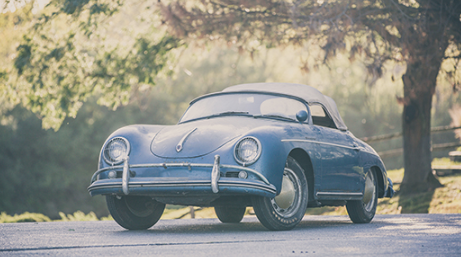
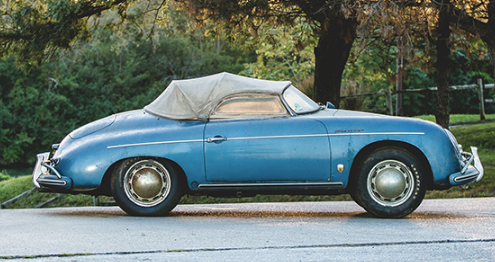
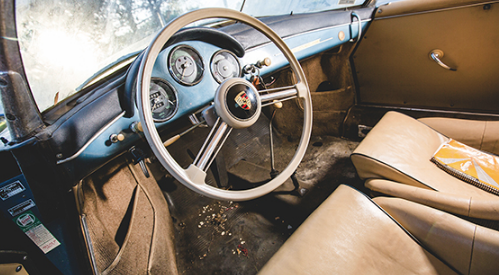
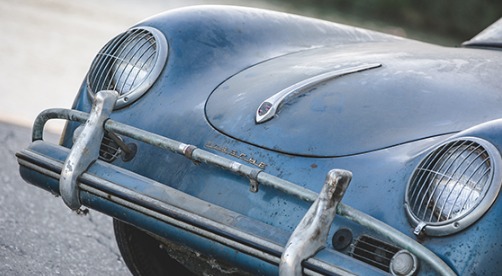
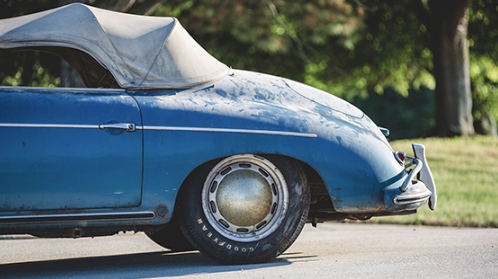
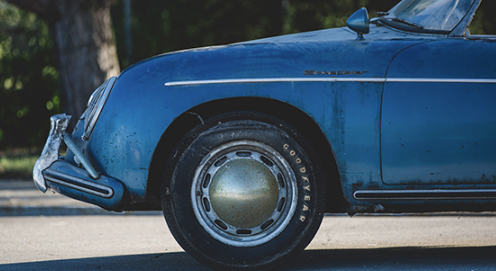
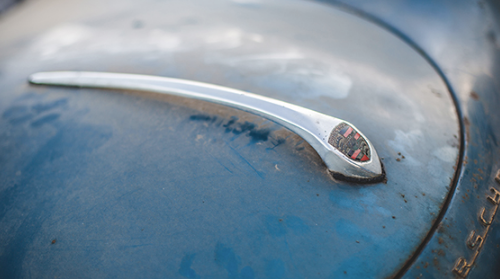
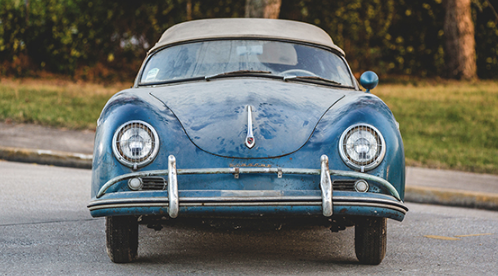
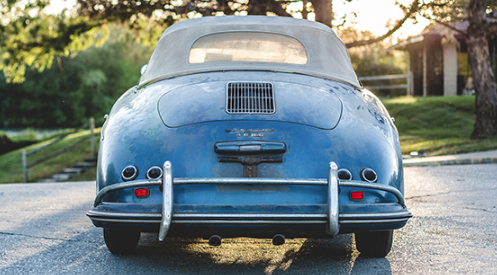



Interestingly, this article discusses the Speedsters’ COA and states that the car was built with “coupe seats in place of the Speedster seats”. The interior photo only shows a partial view of the cars seats but enough to clearly identify the installed seats as the standard equipment “Speedster” seats. Was there any record of the seats being changed in the documentation?
Very interesting article !
When these cars came out, the list price was $2,995.00. They were meant to be a cheapo version, to meet a price mark that wouldn’t scare off the buyers. To me, this sale was just nutso, an extreme example of the backlash against over-restored cars and the awakening desire for “original.” But what do I know? The market speaks!
Back in the mid/late 60s I built what is now called an ‘outlaw’ speedster from an early clapped out pre-A ex-racer. I tossed the original engine & T/A, built a new 12 volt loom and dropped in a S90 & T/A from a wreck, etc…..I might have had $600K worth of fun in today’s dollars….no regrets except passing it on several years after
When I was young the speedster was the stripped down version, but it was the Porsche all the Porsche guys wanted. They were stacked six high at most of the Porsche parts yards and most were rusty even in California. Is it possible to talk 356’s theses days without mentioning “outlaws” I guess not I just mentioned it.